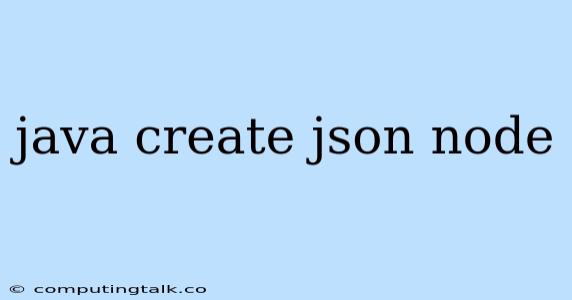Java is a popular programming language that is widely used for building a wide range of applications. One of the common tasks in Java development is working with JSON (JavaScript Object Notation) data. JSON is a lightweight data-interchange format that is easy to read and write. In this article, we will explore how to create JSON objects in Java using the org.json library.
Understanding JSON
JSON is a text-based data format that follows a specific structure. It uses key-value pairs to represent data, where keys are strings and values can be various data types such as strings, numbers, booleans, arrays, and nested objects. Here's a simple example of a JSON object:
{
"name": "John Doe",
"age": 30,
"city": "New York"
}
This JSON object represents a person with the name "John Doe", age 30, and living in New York City.
Using the org.json Library
The org.json library is a popular and widely used Java library for working with JSON data. It provides convenient methods for creating, parsing, and manipulating JSON objects. You can add the org.json library to your Java project as a dependency using your build tool, such as Maven or Gradle.
Creating a JSON Object
To create a JSON object in Java using the org.json library, you can use the JSONObject class. Here's an example:
import org.json.JSONObject;
public class CreateJSON {
public static void main(String[] args) {
// Create a new JSONObject
JSONObject jsonObject = new JSONObject();
// Add key-value pairs to the object
jsonObject.put("name", "John Doe");
jsonObject.put("age", 30);
jsonObject.put("city", "New York");
// Print the JSON object
System.out.println(jsonObject.toString(2)); // Pretty print
}
}
This code creates a JSONObject object and adds key-value pairs representing the person's name, age, and city. The toString(2) method prints the JSON object in a formatted way with indentation for better readability.
Adding Values to a JSON Object
You can add different types of values to a JSONObject, such as:
- Strings:
jsonObject.put("name", "John Doe"); - Numbers:
jsonObject.put("age", 30); - Booleans:
jsonObject.put("isStudent", true); - Arrays:
jsonObject.put("hobbies", new JSONArray().put("Reading").put("Coding")); - Nested Objects:
JSONObject address = new JSONObject(); address.put("street", "123 Main Street"); address.put("city", "New York"); jsonObject.put("address", address);
Accessing Values from a JSON Object
Once you have created a JSON object, you can access its values using the get() method. The get() method takes the key as an argument and returns the corresponding value. You need to cast the returned value to the appropriate data type. Here are some examples:
String name = jsonObject.getString("name");
int age = jsonObject.getInt("age");
boolean isStudent = jsonObject.getBoolean("isStudent");
JSONArray hobbies = jsonObject.getJSONArray("hobbies");
JSONObject address = jsonObject.getJSONObject("address");
Handling Errors
It's important to handle potential errors when working with JSON data. For example, if you try to access a key that doesn't exist in the JSONObject, it will throw a JSONException. You can use a try-catch block to handle such errors.
try {
String city = jsonObject.getString("city");
} catch (JSONException e) {
System.err.println("Error accessing key: " + e.getMessage());
}
Creating Nested JSON Objects
You can create nested JSON objects by creating a new JSONObject and adding it as a value to another JSONObject. This allows you to represent complex data structures. For example, you can create a JSONObject to represent an address and add it to a JSONObject representing a person.
JSONObject person = new JSONObject();
person.put("name", "John Doe");
JSONObject address = new JSONObject();
address.put("street", "123 Main Street");
address.put("city", "New York");
person.put("address", address);
System.out.println(person.toString(2));
Creating a JSON Array
You can create a JSON array using the JSONArray class. A JSONArray is an ordered collection of JSON values. You can add JSON objects, strings, numbers, booleans, and other JSONArrays to a JSONArray. Here's an example:
JSONArray jsonArray = new JSONArray();
jsonArray.put("apple");
jsonArray.put("banana");
jsonArray.put("orange");
System.out.println(jsonArray.toString(2));
This code creates a JSONArray and adds three string values: "apple", "banana", and "orange".
Conclusion
Creating JSON objects in Java is a common task that involves representing data in a structured format. The org.json library provides a powerful and convenient way to work with JSON data in Java. You can easily create JSON objects, add values, access data, and handle errors. By understanding how to use the org.json library, you can effectively handle JSON data in your Java applications.
